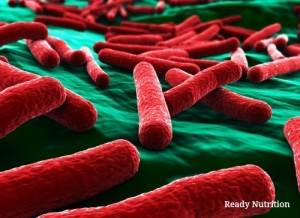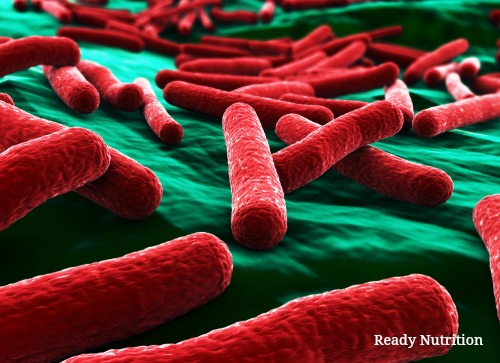Good Day, Ready Nutrition readers, and welcome to Part 2 of the series covering the challenges posed by Food borne illness and diarrhea [2] in a conventional setting, wilderness area, and a grid-down SHTF scenario. Our concentration is going to be heavy on the latter two, as they are experienced in similar fashions (primitive conditions and surroundings). We outlined the categories in the last article. Let’s discuss the environment one will face.
Firstly, during a hunting trip or in a survival situation, there are many forms of wildlife that will serve as a quarry, depending on your geographical locale: deer, elk, wild boar/pig, waterfowl (ducks, geese), rabbit, squirrel, and so on. The basics of field dressing are not going to be addressed in this piece; however, one of the considerations on food preparation of wild game is the maintenance of the meat’s cleanliness.
Much of the dressing out stage where contamination occurs is when gutting and tying off the bung (meaning sealing the rectum of the animal prior to removing the innards). Many inexperienced hunters manage to do one or more of the following:
- Cut through the intestines when dressing out the game, thereby emptying fecal matter into the peritoneum and contaminating the meat,
- Improper tying off of the rectum to allow fecal matter to exit/contaminate the game
- Not segregating the cleaned meat from the offal/debris
- Improper hand washing techniques that spread fecal contamination to the meat
With wild game, the greatest bacterial threat to contaminate meat and lead to eventual food poisoning is with Escherichia coli. One in particular is E. coli O157:H7, and this strain is an enterohemorrhagic bug that produces a verotoxin. The signs and symptoms of poisoning are diarrhea and bloating with normal resolution occurring in about 1 week. The way to guard against this bug is to cook meat to at least 160º F, as well as guard from contamination by fecal matter. Treatments for it involve fluid and hydration therapy. Oral rehydration solution or Gatorade can help resolve it more quickly.
- Tularemia (with the causative organism being Francisella tularensis is also known as rabbit fever. It is an arthropod-borne infection [see the previous posted article entitled, “Wilderness Survival: Preventative Measures and Off Grid Treatment for Deadly Bugs [3],” by yours truly], transmitted by fleas, ticks, and deer flies. Although these arthropods are the vectors (transmitters), the disease is within the meat if improperly cooked. The drugs of choice are Streptomycin, and Gentamicin. Catnip (Nepeta cataria) is a nervine herb that reduces fever and relaxes the patient. It can be taken in tea or capsule form and found in your local health food concerns. Up to 3 cups daily can be taken, but pregnant women must avoid it.
- Salmonella is found especially in eggs and with migratory birds (ducks and geese). This bug is the number one cause of food poisoning. More than 1400 species have been discovered, and their effects range from mild to severely life-threatening. All foods from animal sources must be cooked thoroughly. Once again, it is a disease that resolves through proper hydration and rest. Salmonella outbreaks occur during the warmer months of the year.
Enterotoxins are exotoxins produced by certain types of bacteria. One of them is Clostridium botulinum, and it is endemic/prevalent in the soil in more than 250 species. The bacteria manage to enter through wound infections and also in improperly cooked foods. One may wonder, what wound? Please take my advice: if you have hunted, you know that there are always small cuts suffered from dressing out game (from the knife, from pieces of bone, etc). Any type of game may pick this one up and transfer it to you.
The way to best avoid this one is through proper hand washing techniques, keeping the meat from direct contact with the ground, and wearing rubber gloves when dressing and skinning. If this bacteria sounds familiar to you, that’s because it is: this is the causative organism for botulism. The bacteria themselves produce the toxins that are neurotoxic to humans, meaning they affect the central nervous system. Now keep this in mind as well: improper canning techniques also cause botulism to take root. We will discuss this more in a future article.
- Staphylococcus aureus is the number two causative organism for food borne illness overall, accounting for ¼ of all food poisonings. Symptoms are diarrhea, nausea, vomiting, abdominal distension, and they start from 1-8 hours after being infected with the organism. The bacteria can be found in wild game, poultry, and eggs, along with tuna, potato salad, and macaroni salads of the conventional diet.
- Campylobacter jejuni is a bacterium that causes abdominal cramps, fever, diarrhea, and bloody stools. This organism can be found in cattle and also in wild turkeys, as well as chickens and sheep. The bacteria can be transferred to all of the meat of the animal when it is being slaughtered. Cooking the meat thoroughly is the key to prevention of illness.
Now we’re going to touch on the worms, also called helminthes, or helminthic parasites. The big category to discuss is the tapeworms, and these fall under the Taenia species. The tapeworms infest virtually every type of mammalian large game. Taenia solium (the pork tapeworm) found in wild boar and pig; Taenia saginata (beef tapeworm) found in large deer species; Diphyllobothrium latum (fish tapeworm). They become ensconced in the intestines of these animals and in humans.
The head is called the scolex, and it has hooks and suckers. The worms have up to several thousand segments called proglottids; the terminal (toward the tail) proglottids have fertilized eggs within their structure. These segments break off and pass out of the host upon defecation. The eggs then hook onto a new host that usually takes them in via ingestion. Symptoms include abdominal discomfort, bloating/distension, and change in bowel habits. The drug of choice for them is Praziquantel (Biltricide), a broad-spectrum drug that is highly effective against tapeworms.
A naturopathic aid for tapeworms is in the form of Wormwood (Artemisia absinthium). The dried leaves are made into an infusion with 2 oz of leaves per 2 quarts of water. Bring the water to a boil, and then cool for 1 minute. This prevents the curative properties of herbs to not be leached out or nullified by boiling them. Place the water over the herb, cover it, and let it steep overnight. Strain it and press it. Take 1 cup up to 4 times per day. This batch will last for two days; take the herb for 8 days (4 batches).
Other herbs include Garlic (Allium sativum), and this can be taken 1 clove for 3 times per day preventively; for acute infestations, take up to 3 bulbs. Sage (Salvia officinalis) is effective as well; 2 tsp leaf in 8 oz water and steeped for 15 minutes can be taken 3 – 6 times per day. Finally, Goldenseal (Hydrastis canadensis) as a tincture, 1:5 ratio in 60% alcohol, take 30 – 75 drops up to 4 times per day.
For Roundworm infections (Ascaris lumbricoides) found in the mammalian wild game, the drug of choice is Mebendazole (Vermox).
Some nice-to-know information. Bobcat and lynx have over 45 different parasites inside of their bodies at any given time. In addition, their stool has Toxoplasmosis. Such makes them bad to eat except in an extreme survival situation with no choice. Also you may wish to avoid Armadillos, as they carry Hansen’s disease (almost 50% of the population), more familiar to you no doubt by its common name of Leprosy.
We have covered a lot of ground, here. The most important things to remember in a wilderness situation or a grid down scenario are the following:
- Proper hygiene is going to be the key to proper food preparation
- Hand washing is critical in all phases of meat and wild game preparation
- Sanitize all equipment used (such as knives, bone saws, and such) and allow them to air-dry
- Clean fresh water is the key to keeping hands and equipment from transferring disease
- COOK ALL FOOD PROPERLY AND FOR THE CORRECT AMOUNT OF TIME! (Your local County Extension office has handouts and brochures that give food cooking temperatures and their hold times. These are usually for free; take advantage of this free information)
This concludes the second part of our series. Remember that this article is presented for informational purposes only, and is not meant to diagnose, treat, prescribe, or advise any treatment or therapy. Only a certified, licensed physician is able to do these things. Consult with your family doctor prior to taking any actions discussed within this article. Thanks for tuning in, Ready Nutrition guys and gals, and let it be a basis for your own personal research and study. Take care!
JJ

